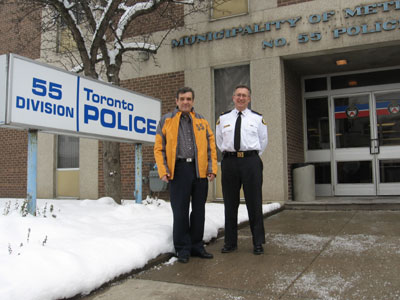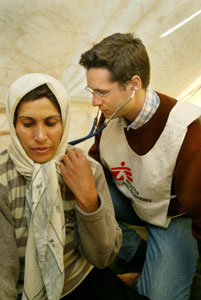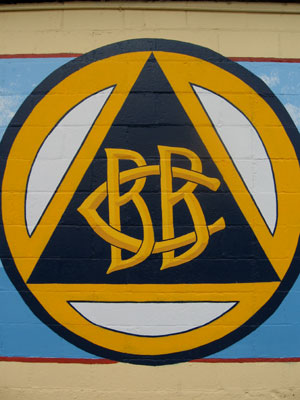The entire philosophy of the Toronto Police Service is heavily focused on community-oriented policing which is a number one priority. The public should understand that the police are accessible and available, and what makes 55 Division unique is that the community takes full advantage of the services offered by the police.
Staff Sergeant Steve Tracy explained some additional concepts to me. He indicated that the officers in charge of the high school programs also run the ESP Program: a Toronto-wide initiative, the Empowered Student Partnership program is a peer mentoring program where students plan, organize and execute a year-long safe schools initiative in their local schools and communities. They are empowered to take the necessary actions to solve issues specific to their school and are able to utilize programs or guest speakers that are available to them through the Police Coordinator at Community Programs, Youth Services.
One important corporate partner of the Toronto Police Service is Tim Horton’s which has created a so-called “Earn A Bike” program, targeted at children between ages 12 and 15. In return for providing 30 hours of supervised community service, children who would not otherwise be able to afford a bicycle participate in park cleanups, graffiti eradication and other community based programs. In the process they gain a totally new understanding of the role of the police as well as a new perspective on mischief such as graffiti. At the end of the program these children are presented with a bicycle and a helmet by Tim Horton’s, and last year 14 children in 55 Division had an opportunity to participate in this program. Staff Sergeant Tracy says that “small things like this can have a big impact on the community”.
He also explained that 55 Division has an auxiliary police program that encompasses volunteer police officers that often help with crowd control during special events like the Toronto International Beaches Jazz Festival or the Taste of the Danforth. These are trained civilian volunteers, outfitted in uniforms that are similar to those of full-fledged police officers, and they are trained in civilian authority and basic use of force. Their equipment includes a baton and handcuffs, and their main role is to assist with community events.
Events like the Beaches Jazz Festival that attract large crowds require a large uniformed presence to provide for safety and public confidence. Auxiliary police officers also help to locate missing children during special events; in addition they assist with community outreach and crime prevention and play a critical role in supporting the police force which, like any other city department, is facing limited resources.
Community mobilization is also an important objective of the Toronto Police Service. With an $800 million budget the Police Force is highly accountable to local taxpayers, and a two-year business plan lays out the service’s priorities for the next two years. Community mobilization also encompasses turning Community Response Unit officers into “long-term problem solvers” dealing with problem addresses, neighbhourhood disputes, noise complaints or other community problems that do not have an immediate fix.

The women’s holding cells
Staff Sergeant Steve Tracy explains that problem addresses often have some criminal element associated with them, for example drugs might be at the root of the problem. But there are also other stakeholders involved, for example a negligent landlord. The problem address might affect Social Services, the Department of Public Health, Bylaw Enforcement or the Fire Department, and might require a holistic solution in order to solve the problem. Cases like these are not just a police issue. The police’s role is to involve the various stakeholders to get the problem fixed. Simple examples of community mobilization include Neighbourhood Watch programs where the neighbourhood starts to solve its own problems. The Police Services simply do not have enough resources to handle all issues, and it becomes critical to mobilize the community and involve them in the problem solving process.
We also touched on the role of the CPLCs: the Toronto-wide Community Police Liaison Committees are made up of community volunteers and police service representatives from each division. Each committee is intended to reflect the demographics of the local community to work together in identifying, prioritizing and problem-solving of local policing issues. The CPLCs achieve this by being proactive in community relations, crime prevention, education, mobilization and communications initiatives, and by acting as a resource to the police and the community.
In the Beach, for example, the Community Police Liaison Committee would have representatives from the main business improvement areas as well as major event promoters and regular citizens. This gives all the stakeholders a chance to hear one another’s voice, and Staff Sergeant Tracy adds that at 55 Division the CPLC works extremely well. Resources, ideas and information are shared for the benefit of the entire community. The Community Police Liaison Committee also has a Youth Scholarship Fund where money is raised for bursaries that go to local high school students. The entire community is working together to make the neighbourhood a better place.
Individual police stations participate in a variety of corporate initiatives, and many initiatives are the results of partnerships with the community. Basketball and volleyball programs, for example, are funded by ProAction Cops and Kids, a non-profit organization designed to provide funding for programs targeted at at-risk youth. These programs are designed for youth between 11 and 18 years of age and allow police officers and at-risk youth to interact in constructive, non-confrontational circumstances to develop a better understanding of one another. Programs encompass arts, sports, education, safety, mentorship and camping, and to get a better understanding of ProAction’s role in the Beach community I had a chance to talk to Police Constable Lisa Cowling.

PC Troy Lashley and PC Lisa Cowling
Together with Police Constable Troy Lashley, PC Lisa Cowling created a beach volleyball program for children at risk. In the summer of 2006, 18 male and 20 female students aged 11 to 16 years old were selected from two different community centres, and they would take turns coming down to Ashbridges Bay on a Wednesday evening to learn how to play beach volleyball. ProAction provided the funding for nets, balls and refreshments, and every evening would be capped off with a barbecue. Police Constable Cowling explained that the participants were taught the basic skills of the beach volleyball, but also other concepts such as camaraderie, teamwork, honesty and fairness.
Many of these children had never had an opportunity to spend much time at Toronto’s waterfront, and this was also an ideal way of getting to know police officers on a human level. The officers would be running the program in plain clothes, and by the end of the program real friendships had developed. On the final day of the program, a big barbecue was held for the two groups from the different community centres, and two professional Beach volleyball players came out and played games with the kids. Fred Koops, owner of local beach volleyball outfitter Overkill designed and donated t-shirts for the children. This coming year, other police divisions will be invited to select their own at-risk youth to participate in the program and the program will be expanded.
My visit to 55 Division was capped off with a guided tour through the facility by PC Cowling. She showed me the entire three levels of the building, including the holding cells for men, women and teenagers.

The “Beat The Heat” beach volleyball program in action
This afternoon had been a fascinating lesson in policing, and my eyes were truly opened to the broad range of positive roles that the police play in the community. The motto of the Toronto Police Service “To serve and Protect” is definitely being put into action in the Beach.




